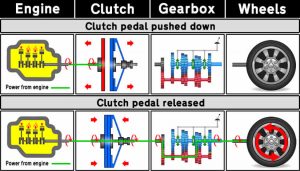Why Does a Car Need a Clutch
If we can think of a car with a manual gearbox as having four main components:
- Engine
- Clutch
- Gearbox
- Wheels
Those four components allow the car to move off smoothly from a stationary position by use of clutch control, to control the speed of the car by changing gear and to allow the car to stop without stalling the engine.
The clutch allows for the connection between the engine and gearbox to be broken. If we were to remove the clutch from those four components, the engine, gearbox and wheels would have a constant connection.

Without the clutch, it would be almost impossible to get the car moving without first pushing it in motion. You wouldn’t be able to change gear, meaning the car would just have a single gear limiting its speed potential. Also, the engine would stall each time you stopped the car. So essentially, a car with manual transmission needs a clutch so that it can:
- Move off smoothly from a stationary position
- Change gear
- Stop without stalling the engine
Move Off Smoothly from a Stationary Position
You’ve probably heard the term ‘clutch control’. Clutch control is essential for moving the car off from a stationary position in a controlled and smooth action. Clutch control is also important for maintaining a very slow speed of your car when needed. But why does a car need a clutch to move off from a stationary position?
As we know, the clutch breaks the connection between the engine and the gearbox when the pedal is pushed down and reconnects the engine and gearbox when the pedal is raised. This connection is made via friction plates that press very firmly together.

The important process here is to ensure the clutch pedal is raised slowly so that the rotating plate connected to the engine has time to start spinning the plate connected to the gearbox. If you release the clutch pedal too quickly, the engine will stall.
Change Gear
We also need a clutch for changing gear. Inside a gearbox are 5 or 6 forward gears and 1 reverse gear. When a gear change is made, different cogs, or ‘gears’ mesh with each other to enable varied speed output of the car. To stop the gears from grinding, the power from the engine must first be disconnected.
Power from the engine is disconnected from the gearbox when the clutch pedal is pressed down. This allows the gears to synchronise their speed and mesh together, allowing for a gear change to occur without grinding them. After a gear change has been completed, the clutch pedal can be raised, reconnecting the engine to the gearbox. For further information on how the gearbox works, see how gears work in a manual car.
Stopping the Car without Stalling the Engine
A car also needs a clutch so that when the vehicle comes to a stop, then engine doesn’t stall. Just before the car stops, the driver pushes the clutch pedal down, disconnecting the engine from the gearbox. If the driver doesn’t do this, power from the engine will continue right to the wheels, meaning the engine would stall when the driver brakes to a stop. Neutral gear is another way of disconnecting the power, so once the driver does this, the clutch pedal can be raised.